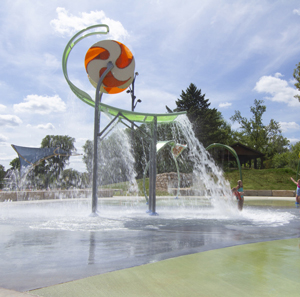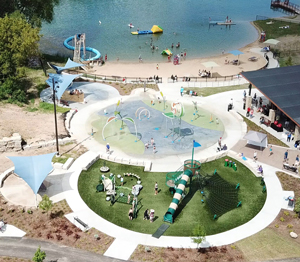Smaller-Scale Waterfront Projects With Big Impact

A 2020 paper that analyzed waterfront development in general and four cities' efforts specifically detailed challenges and solutions in maximizing properties adjacent to oceans, lakes and rivers.
"Waterfront Development and Revitalization in American Cities" focused on Milwaukee, Louisville, New York City and Pittsburgh. But the desire to best connect commerce and citizens to a natural resource is not limited to large population centers. The vast majority of municipalities and private entities that build or want to build recreational facilities on and by water are much smaller.
Towns, campgrounds, resorts and businesses attract and serve people with beaches, piers, boardwalks, boat launches, playgrounds, splash pads, trail systems and waterparks. The work that goes into such projects—physically and financially—is complicated and expensive but can be accomplished successfully with planning, partnerships, resourcefulness and creativity.

Anytown USA like Verona, Wis., or Post Falls, Idaho, have made or are making their lake- and river-side park dreams reality. In some cases, bodies of water have been created where there were none.
"You're really creating an environment and creating a sense of place around it, and that can be done on a large scale and a small scale so don't be intimidated that, 'Oh, we have such a small space, how do we do all that here?'" said Ron Romens, founder of a Verona, Wis.-based consultant and supplier of waterfront and park products. "There are a lot of ways and ideas to engage people, and many times it doesn't have to be super crazy expensive."
Romens and his staff have been a part of many projects, from providing and installing inflatable structures for water fun, as well as benches, shade structures and splash pad equipment, to helping with design.

"Over the last several years we've seen large-scale river and lakefront developments where they're bringing in marinas," Romens said, "and when you have the marinas, you have the restaurants, and how do you tie those into the other land-based or family recreation where land side can come in with transportation and trails and enjoy that space?"
Fireman's Park in Verona, Wis., began decades ago when the town reclaimed an eight-acre spring-fed quarry that boasted only a small beach and was underutilized. Other than the beach, there was a cottonwood tree, an old bathhouse, a fishing pier and some picnic tables.
"The cottonwood tree was the shade structure," said Romens.
When the town decided the aquatic center it hoped to build would be too expensive, its focus turned to improving the nearly-40-acre quarry-side property.

Verona hired an engineering firm to design a water-centric masterplan for the property. Bike paths converge from both sides, and the area includes fishing piers, soccer fields and basketball courts, parking lots, a playground, inflatable water structures, a waterslide, shade structures and an elevated artificial turf sunning deck.
From the parking lot visitors encounter a pavilion, then the 3,100-square-foot playground that leads to a 3,600-square-foot splash pad, then the beach.
"Really it was about in the design process, how do we make this for the entire community?" said Romens. "How do we serve all ages, multigenerational, cross-generational, really a community hub for all these different abilities and ages?
"When I go there and I observe how people recreate, it's probably one of the best park designs we've been involved with over the years because it engages all ages. You'll go there on a Thursday afternoon and see senior couples sitting under a shade structure having a picnic and a mom with kids 10, 5 and 3 by the concession building.
"It's a great place to people-watch. That really draws community and energy when you can have all the ages and have them active in a recreation place."
The park is public though passes are sold to access the water features, divided into shallow and deep water play zones. The revenue generated pays for staffing.
Romens said the price tag for the entire project, $3.5 million, was a third of what the aquatic center would have cost.
"It's something a small town can get into," Romens said.
Another way a smaller municipality can afford premium waterfront recreation areas is to phase the project. The population of Post Falls, Idaho, has doubled since the start of the century, and keeping up with that growth has necessitated an allocation and rationing of resources to serve different demographics.

The town's reclamation and development of a stretch of Spokane River was in response to the residents' longtime wish to value and improve the property. That project however has been planned and begun simultaneously with the construction of two separate sports complexes, one for youth and one for adults. The town authorities had begun changing the stretch in the 1990s, but without a long-term or overall plan, and it remained mostly undeveloped until a 2012 masterplan sparked the ongoing serious effort.
"We're a fast-growing community with limited money," said Post Falls Parks and Recreation Director David Fair. "There were always other priorities."
Fair said Post Fall residents cherish the area known as Black Bay because of the diversity of the 64 acre space. There's a natural rock tower, named Ford Rock, a rugged bay and of course the river.
"From space to space you get so many different experiences," Fair said.
Donated to the city by a council member in the 1940s, the stretch was leased for lumber purposes for decades. It was storage for the streets department, and an informal dump. Recreationally, it was used for viewing, swimming and fishing. Along with boat launching, mountain biking and motorcycling, the banks were eroded but fortunately the water was not polluted with contaminants.

The city first addressed the area in the mid-1990s with cleanup followed by the installation of a parking lot, planting of trees and construction of a trail along the access road within the park. A lot of soil was added because of what had been washed away from the lumber days. Not much changed after that until the town hired landscape design firm Civitas.
"We wanted to know from a different standpoint what could be done with it," Fair said. "Were we missing things? Having a fresh look at it was critical. Having a look at it from a company that specializes in natural preservation while still allowing public access. Parks are for people, and it's critical to allow that connectivity."
Scott Jordan is a partner at Civitas and has worked closely with the town on Black Bay Park from the start. He said at first Post Falls wasn't asking for much.
"The number one thing they were asking for were benches and trash receptacles, but once we showed them what was possible, they started wanting more," Jordan said. "I realized there was no way they could afford all this, so we introduced the phase process. We realized very quickly their eyes were bigger than their belly. We worked with them prioritizing—how can you add amenities that are most important to you now and supplement it as you go along?"
Fair said in community meetings residents picked their 10 top priorities, then went through a budget exercise that showed them they could have everything they wanted if they did the park piecemeal over a decade.

Since the top priorities were to stabilize and protect the bank, and add utilities, a boardwalk and a plaza, those steps are in the first phase. A playground was moved to a later phase because of budgeting, said Fair, but the prep work for it will be included in the first phase.
"As we go back to install the playground, we don't have to tear up anything, we'll have the pad ready to go," Fair said. "We're doing things that maybe the public won't see 100%, but it allows us then to make that next improvement without any interruption to the existing site. By doing a lot of prep work that the public doesn't see we've lowered construction costs in the long run."
Fair said this type of resourcefulness also pushed back a new parking lot, as it made more sense to do that when it can piggyback on eventual city road improvements. The town hopes to break ground on the first phase in 2022 and be done by 2032, "unless we come up with extra money, which we might," said Fair.
The town has three main sources of funding: impact fees, general fund fees, and grants. Money will be saved because Fair has a staff that is very good at carpentry, able to build restrooms and shelters from scratch. Every little bit helps, he said.
"If you wait until you have enough money you'll never get it done, because you'll never have enough money," said Fair. "It's like any big problem, you break it down into manageable bites. It's a puzzle. Between myself and my staff and working with Scott and his team we were able to look at, how can we place things together so we weren't going back in and redoing any work, we're not changing anything, how do you layer it in?"
"The number one thing they were asking for were benches and trash receptacles, but once we showed them what was possible, they started wanting more. I realized there was no way they could afford all this, so we introduced the phase process. We realized very quickly their eyes were bigger than their belly. We worked with them prioritizing—how can you add amenities that are most important to you now and supplement it as you go along?"
— Scott Jordan, Civitas
Fair said while resourcefulness and common sense is critical in taking on large projects in phases, marketing can't be forgotten when dealing with pubic works.

"What gives you the biggest bang for your buck?" he asked. "We're doing a lot of stuff the public doesn't see, but if that's all we did we wouldn't have public support. You have to make something the public notices. That's why this bay stabilization is critical. It supports everything else, and it was a number one desire by the public by a mile, but water access was number two.
"Putting in that boardwalk and that water access and making it ADA will be very noticeable. As they come down into the park and are greeted by the new plaza it has a pop value. You balance those things out. The other stuff can be done in phases."
The "other stuff" when ribbons are cut in 2032 includes tennis and basketball courts, trails, grassy areas, a playground and access from all sides. The bonus is a view of the town from Ford Rock.

Jordan said the next phase will add trails and the phase after that move parking from the center of the park to the edges so the middle can be used recreationally.
"It really is about providing that access to everybody," said Jordan. "Reclaiming spaces that have gone from post-industrial uses to community gathering space. Trying to create as much meaning for as many different folks as possible along a waterfront.
"Originally when waterways were being reclaimed, a lot of it was about linear systems, bikeways, walkways, ways for people to move along the water. In the last 10 years or so as communities densify elsewhere, they're becoming places where a lot of other recreational trends are happening. Pickleball courts, volleyball courts—you're seeing a lot more places using these to supplement their bigger recreational needs as a community so you're seeing more active recreation amenities."

Community engagement from the masterplan stage was key, said both Jordan and Fair. Public meetings, online accessibility to meetings, social media, all were tools to decide what to do and when. Fair said one of the most important decisions happened before the residents were involved—the town's choice of design firm.
"Find a partner or consultant who will listen," Fair advised those starting the same journey. "You have to be able to communicate. Being able to communicate lets you know quickly if you're on the same page. But also they have to be honest enough to let you know when you're wrong or not seeing it right. If you cannot communicate openly and be willing to share differences then you've got a problem."
Through all the delays—whether from weather or permitting or funds sourcing—Fair stayed optimistic that the phase plan was the long-term solution for a small town with big waterfront development goals.
"Nothing ever goes perfectly smooth," Fair said. "We've really had to work at it, overcome a number of hurdles. It's had hiccups. But if you keep focused on it and keep working at it, you get through those. You go over an obstacle, under or around, but you solve it. If that becomes a big obstacle, you break it down into pieces you can manage. There's nothing that can't be done; it may go just a bit longer."
Jordan agreed alignment was most important in all projects, but specifically with phased operations that agreement has to be not just on the end goals.
"You can create the strategy for developing it, but it requires creating a vision that everybody believes in and getting buy-in from the community, creating alignment and agreement about what are the most important things to develop first," he said. "That way you can create that benefit right off the bat, and if you do that then the next phases are desirable to the community because they're already realizing benefits.

"We joke in our office the only reason to do phase one is to make sure the other phases happen. They can realize the near-term benefit with a long-term vision."
Romens said not only is there hope for small towns and commercial enterprises to hit well-done and sizable waterfront targets, it's very affordable to create a body of water where there is none and then develop next to it.
His company was involved in helping Sturgis, N.D., plan to turn an abandoned 29-acre fairground property into a money-saving manmade lakeside attraction. The town first wanted a waterpark on the site until the $12 million price tag intervened. The price tag for not just the 4-acre lake dig, but splash pad, inflatable water play structures, miniature golf, lighting and landscaping, parking lot, a parks building, watercraft pier and accessories came to $3.5 million. Better yet, the conservative estimate of potential revenue is $180,000 per year, according to the city's website, with nearly the same amount for operational costs.
"They're looking at using it in the summer as a revenue generator and tourism attraction," Romens said. "In the off-season they've got this great community park."
Romens said manmade lakes include lining and aerators and need biologists to treat and monitor water. In snowy climes, the displaced dirt from digging the lake can be used for a sledding hill or a waterslide.
"In designing the space, how's it going to be used, how is it going to serve the different demographics, how are you going to bring people together, how will they circulate through it?" Romens said. "With regard to the specific recreation components, when a family comes, if it's a 16-year-old, a 12-year-old, a 7-year-old and 2-year-old with mom and dad, how are you going to keep them busy, how will they be entertained?
"How do we activate that space? How do we turn it on and turn it off?" RM



